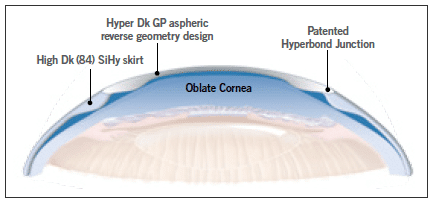With hybrid contact lenses, you get the vision of RGP lenses with the comfort of soft lenses. That’s the theory anyway. Why bother? Why not stick with one or the other?
The problem with soft lenses is that, although comfortable, they are very thin and flexible and drape over your cornea. This is fine if it is a normal, healthy cornea with a regular shape. But the problem occurs when you have an irregularly shaped cornea, such as in keratoconus. Soft lenses just don’t provide a regular surface in the way hard lenses do. BUT, hard lenses (RGPs) are not tolerated well by everyone.
Keratoconus is often associated with allergy and itchy eyes, and the hard edge of the lens can irritate some people to the extent that comfortable wear is not possible. This used to mean giving up on contact lenses and making do with the poorer vision provided by glasses. Then along came the hybrid contact lens.
How do Hybrid Lenses work?
These lenses have a central zone made from rigid gas permeable (RGP) material. Outside is another zone, called a skirt, made from soft lens material. In this way, the irregular cornea gets the structure it needs to see clearly, while the soft skirt provides comfort more like a soft lens.

What are the cons?
Hybrid lenses are not cheap and require careful handling to avoid damage along the junction between the two zones. With that said, they are very popular, especially amongst keratoconus sufferers.
How can I get hybrid lenses?
These lenses require an expert contact lens practitioner to achieve the right fit and maximise your chances of success. At The Eye Practice, we are experts in advanced contact lens fitting for keratoconus and other irregular corneas (including after corneal transplant).




























